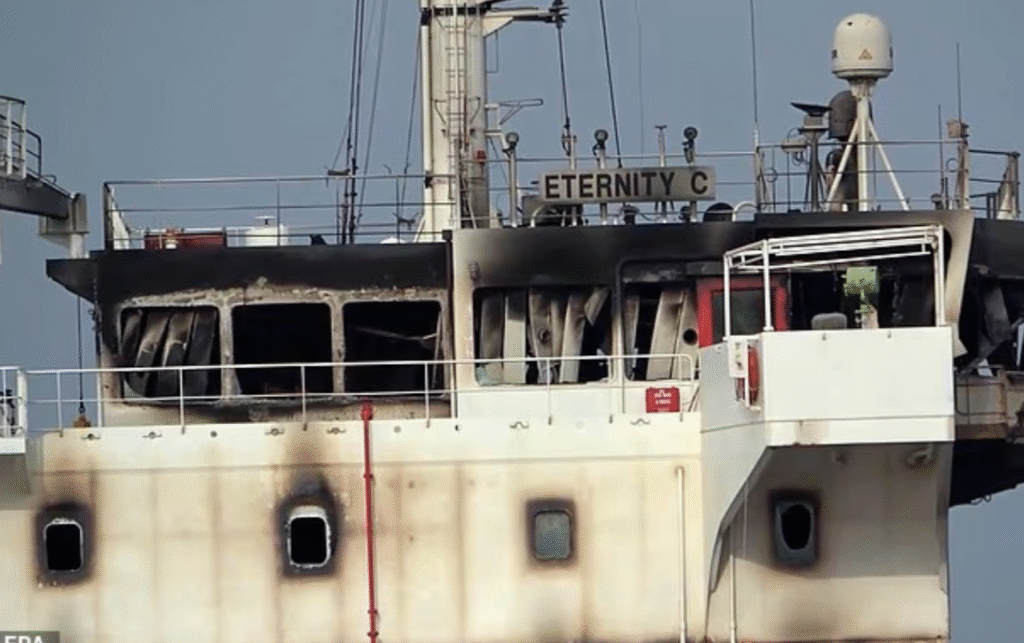The Houthis have intensified their attacks in the Red Sea, targeting Israel-bound and European vessels in a bold attempt to pressure Israel amid the Gaza conflict. Backed by Iran and equipped with advanced drones, missiles, and air defense systems, the Yemeni rebel group has transformed into a significant regional threat. With the U.S. conducting strikes and Iran reportedly shifting missile production to Houthi-controlled zones, tensions are escalating. This blog explores how the Houthis are reshaping the security dynamics of West Asia and posing a serious challenge to Israel and its allies.
Houthis Escalate Attacks on Israel-Bound and European Ships
In a major escalation this week, the Houthi rebel group from Yemen has launched a fresh wave of attacks targeting Israel-bound and European vessels. This aggressive uptick in hostilities comes amid the ongoing conflict in Gaza, as the Houthis vow to pressure Israel into halting its military operations.
The past few days have seen multiple incidents of vessels in the Red Sea coming under threat, prompting heightened alerts and even evacuation orders. Alarm sirens have rung out across Israeli cities, underscoring the intensity and reach of the Houthi campaign. Communications from ship captains paint a dire picture, with orders to abandon vessels under fire and confirm threats over open channels.
What was once a regional insurgency in northern Yemen has now evolved into a formidable threat on the global stage. The Houthis have positioned themselves not just as a regional power but as a key player affecting a global $1 trillion cargo route that passes through the Red Sea. The movement’s transformation from mountain insurgents to maritime and aerial aggressors marks a dangerous shift in West Asia’s military dynamics.
A particularly symbolic strike came shortly after Israel’s recent war with Iran, when the Houthis targeted the Shefa region near Tel Aviv—an area already devastated by Iranian missile barrages. The attack served not only a tactical purpose but also a psychological one, tying Yemen’s Houthi forces more directly into Iran’s broader confrontation with Israel.
The United States has been actively involved in trying to suppress Houthi capabilities. The USS Harry S. Truman aircraft carrier led Operation Rider, a campaign aimed at neutralizing Houthi missile and drone systems. US President Donald Trump, returning to office earlier this year, made it unequivocally clear that any attack on American vessels in the Gulf of Aden or Red Sea would provoke a fierce response. In retaliation, Houthi forces claimed to have shot down US MQ-9 Reaper drones and even American fighter jets.
By May, American air power had pounded hundreds of Houthi targets across Yemen, and President Trump declared a short-lived victory. However, the US National Security Adviser at the time, Mike Wall, revealed a more troubling reality: the Houthis had not been fully neutralized. Instead, they had managed to preserve and possibly upgrade their arsenal, which includes advanced air defense systems, anti-shipping cruise missiles, ballistic missiles, sea-skimming drones, and more.
Adding to the growing concern is Iran’s deepening involvement. While Iranian Revolutionary Guard forces have paused their direct missile strikes against Israel, intelligence reports suggest a strategic shift. Iran is reportedly relocating its drone and missile production to Yemen, specifically in areas under Houthi control such as Sada, Haja, and the capital Sana’a. This decentralization makes it harder to target and disrupt Iran’s weapons supply chain, while turning Yemen into a launchpad for further regional destabilization.
Yemen’s own Information Minister has confirmed these developments, stating that the Houthis and Iran are essentially joined at the hip in a shared military venture. The alignment strengthens what Iran calls the “Axis of Resistance,” a loose coalition of militant groups stretching from Lebanon to Syria to Iraq and now deeply rooted in Yemen.

The consequences for Yemen itself are dire. Once a largely local conflict, the country is now entangled in West Asia’s broader geopolitical conflicts. Its key shipping infrastructure, such as the Huda port, and major urban centers like Sana’a, are now high-risk zones that could be targeted by Israel or its allies at any moment.
This evolving scenario suggests that Israel’s next major military engagement might not emerge from its northern borders with Lebanon or Syria, but rather from the mountainous terrain of Yemen. The use of Iranian drones launched from Houthi-controlled territory could redefine the geography of conflict in the Middle East. The war, if it breaks out, could be airborne, maritime, and deeply asymmetric—intercepted not just over Gaza or southern Israel, but far across the Red Sea and Arabian Peninsula.
The Houthis, bolstered by Iranian support and an arsenal that grows more sophisticated by the month, have sent a clear message: they are not backing down. As the group continues to challenge Israel and its Western allies on land, sea, and air, the world watches with growing concern over the next chapter of instability brewing in Yemen.

